The AMD Llano Notebook Review: Competing in the Mobile Market
by Jarred Walton & Anand Lal Shimpi on June 14, 2011 12:01 AM ESTPower Gating
With 1.45 billion transistors on die, Llano relies on extensive power gating in order to keep things in order. The APU is split into two independent power islands: the CPU and the GPU. The memory controller and North Bridge both live on the GPU's power island. Each island has its own independent voltage source.
Everything from an individual CPU core to the entire GPU or virtually the entire APU package can be power gated. AMD provided photon recombination images to show the impact power gating the GPU can have on leakage current:
Although not depicted above, Llano can also fully power gate the x86 CPU cores or both the CPU and GPU if the entire APU is in a deep sleep state. Being able to completely power gate CPU cores or the GPU is an important part of enabling the next major feature of Llano: Turbo Core.
Turbo Core
All processors whether CPUs, GPUs or APUs have to be designed to strict thermal and power limits. OEMs need to know exactly what sort of chassis they'll be able to build around these chips and as a result the chip vendors provide guidance in the form of specifications, including the chip's thermal design point (TDP).
In the old days of microprocessors things were simple. You had a single core that ran all the time and it consumed all of the available thermal budget allocated for that core. AMD and Intel eventually enabled dynamic clock frequencies which let your single core underclock itself when it wasn't being used, which helped reduce power and extend battery life. Then came the multi-core era.
CPUs couldn't just start putting out twice as much heat now that they had two cores; instead, each core had to consume less power. The chip guys achieved this by running the cores at lower frequencies and voltages than they did in the single-core days. Two cores paved the way to four cores, which meant another reduction in clock speed per core. Sure we got much better multi-threaded performance, but for single-threaded applications performance wasn't as great as it could be. Users had to make a tradeoff: good multi-threaded performance or good single-threaded performance; you couldn't have both. Until power gating came along that is.
Without power gating you can never really shut off power to an idle core. The transistors aren't switching but power is still dissipated thanks to leakage current. Remember that transistors don't simply stop conducting electricity when they're off. The smaller they get, the more leaky our beloved transistors become. Power gating lets you physically block the flow of current to the transistors that are being gated, so when they're off, they're actually off. With an idle core shut off, now you have the extra TDP headroom to run any active cores at higher frequencies.
Intel does this with a technology it calls Turbo Boost. Intel looks at current draw and thermal sensors spread out all over the chip and determines when it has the available thermal headroom to turbo up any active cores. AMD implements a similar technology in Llano (and previously in their hex-core desktop parts) called Turbo Core.
I say similar but not identical because AMD's approach differs in a very important way. While Intel looks at current draw and temperature data, AMD looks at workload. Each activity within the Llano APU is assigned a certain power weight (e.g. an integer multiply is known to require a certain amount of power). Llano is aware of the operations it's currently working on and based on the weights associated with these operations it comes up with a general estimate of its power consumption on a per core basis. I mention this is an estimate because it correlates digital activity to power consumption; it doesn't actually measure power consumption.
Based on the number of events and their individual weights, AMD estimates the power consumption of each core and determines how much TDP headroom exists in the system. If the OS is requesting the highest p-state from the CPU and there's available TDP headroom, Llano will turbo up any active cores up to a maximum frequency. Like Sandy Bridge, Llano is able to temporarily exceed the APU's maximum TDP if it determines that the recent history of power consumption has been low enough that it'll take a while for the APU to ramp up to any thermal limits.
One major limit of Llano's Turbo Core is that the GPU can't turbo up in the event of the CPU cores being idle. Only the CPU cores can turbo up if they have available headroom. I suspect future versions of Llano will probably enable GPU Turbo Core as well:
It's unclear to me at this point what shortcomings or advantages exist for AMD's Turbo Core method vs. Intel's Turbo Boost. At the bare minimum the two are finally comparable although they use different approaches to attain a similar end result. AMD doesn't yet have a method of actually displaying Turbo Core frequencies, unfortunately, so we're operating a bit blind at this point. Over time I hope to have a better idea of how AMD's solution stacks up.


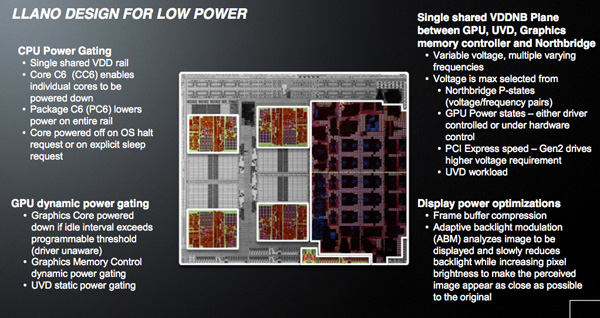
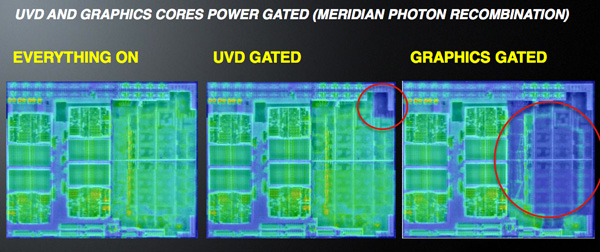
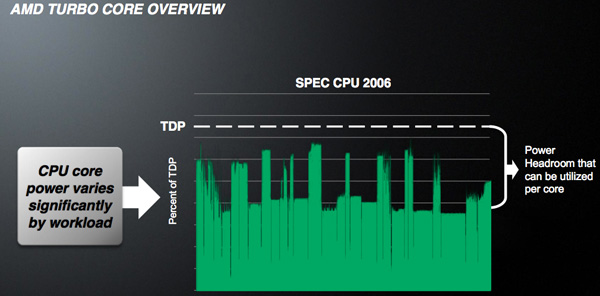
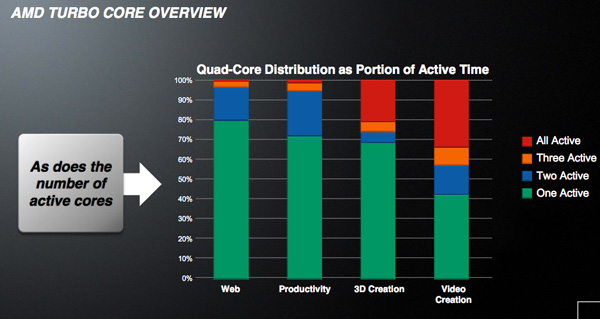
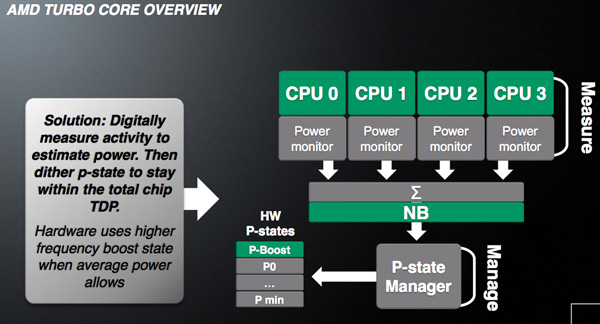
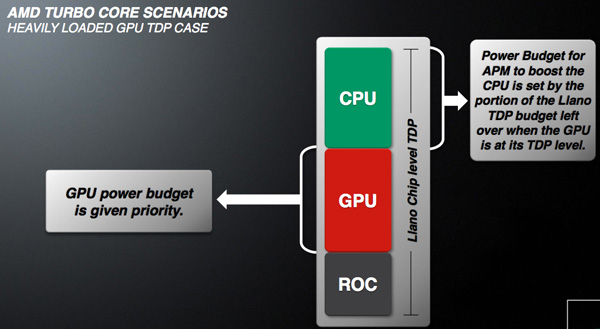
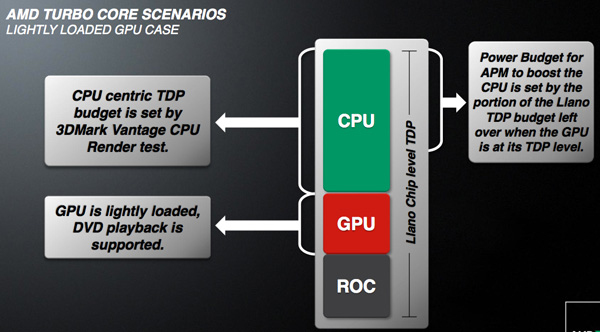








177 Comments
View All Comments
strawhat pirates - Wednesday, July 13, 2011 - link
intel only win on advertising alone ...the rest? thumbs down for InteLosers!! #boooo ...
and intel is only a theory core ...*core fuck!! there is no definite proof .. :@
FORZA AMD!! AMD till die!!
msroadkill612 - Tuesday, August 2, 2011 - link
Not many economists here. can u say SUPPLY & DEMANDIts silly to make a fuss about relative prices att this stage - will always be a supply shortage for a good new product & early adopters happy to pay a premium. Its the learning curve that really costs. Going down a dead end is the real bummer.
b/ its a business - if u keep waiting for the ideal product - u go broke - amd & intel alike
personally, i think brazos shrunk to 28nm or a native 2 core llano that could be a killer product - sub 10w/25w very functional apuS.
I also think if amd get marketing right, we are at a watershed. Intel have made amd dance to their cpu tune, now amd can do the same w/ gpuS
Interesting battle betw intel & tsmc in fabbing. tsmc could win - which proves the amd model right
Lugonux - Thursday, September 8, 2011 - link
I think AMD might have hit the sweet spot with this one, no amazing technology breaks as such but as everyone is keen to point out business/general computing doesn't require much processor power while at the same time multimedia is becoming more and more important and the amd destroys the intel on this front. Serious gamers will still want to go intel/discrete as its simply the best but i suspect the amd laptop would be very appealing for a lot of people like myself who have a 'main rig' and wouldn't mind a backup for when we're travelling/at the gf's without spending a crapload of money on cpu power we'll never use which sadly seems to be the only way of getting a laptop you can game on atm (HD3000 just isn't enough). Overall i'd say good move AMD with limited resources, a shrewd move.Btw i read to like page 10 then skipped to the end as i was getting tired so sorry if i've simply aped someone.
Lugx
MrGaZZa - Thursday, September 15, 2011 - link
Anandtech,I always read your reviews and this is by far the worst comparison in ages!!
And i know the AMD llano APU and discrete graphics can be hard to work out, but I feel that comparing a i7 with a 540m against the lowest A8 model with only a 6630m is wrong.
try comparing the A8 3530mx with the 1gig 6750m. This would be atleast 15% faster than all the benchmarks on here.
People are really getting the wrong idea and figures from here and other poor reviews.
And intel fan boys, I know the Intel i5/i7 would walk all over the AMD APU's in single thread,
but in realworld tests 'media / gaming' these AMD llano laptops walk all over the Intel for performance and battery life.
I own a A8, I was going to get a i7 2730m with 1gig 6770m but my mate at harveys benchmarked that against the 3530mx with the 6750m crossfired with the onboard 6620G 'which is the interaged graphics' and honestly it was like i said 10-15% better.
given that the AMD llano drivers and crossfire can only can get better from now on .. i really feel these bring a new oponent to the table.
I will run benchmarks on my A8 laptop and post youtube links for you people to show you.
lazymangaka - Monday, December 5, 2011 - link
Barely anybody will read this comment, but I have to say: Intel must design their processors with synthetic benchmarks in mind. In making the step from a Core2Duo to an A4-3300m, I noticed a huge jump in performance in everything I do. Everything simply runs snappier. Synthetic benchmarks can throw a million different numbers against the wall, but at the end of the day the performance that I feel is all that matters to me. And AMD gets my vote in that category.Tuberocity - Saturday, December 31, 2011 - link
Unfortunately, mine is cosmetically not perfect, but I noticed it was also warped, the base that is. the lid won't even touch the base when closed. too much, I must return, and get another, or buy off HP's site. Anyhoo, havn't read all the posts in this thread, but I think the review lacking also. The AMD Llano APU, meaning the 3500M & up series are considerably underclocked as supplied in your laptop. Since I must return mine, I havn't fooled around with overclocking yet, but from what I understand, it is so easy, a child of 2 could do it. Just some simple, very simple overclocking, and you have an AMD APU that competes with high end i5 chips, and the standard graphics on the AMD die, radeon 6620G runs circles around intels offering, the HD 3000. The 6620G will play games intel's chip won't even load! I am in a quandry as to whether to get both, the on board graphics, and the extra 1GB GDDR5 Radeon(TM) HD 6750M Graphics card as I have heard they have driver problems, but I will probably go fo it anyway, and hope they have been worked out, or will be worked out in the near future. This laptop top with both graphics on board, the 3510MX APU, 6 GB ram, CD/DVD, 15.6, Windows 7 Premium, and the coup de grace, BEATS AUDIO, Iv'e listened to them all, and with headphones, Beats is the best. Speakerwise, Beats takes seconed over the Harmon Kardon I heard on a Toshiba laptop, but then again, if you opt for an HP 17" model with the subwoofer, i may sound a lot better. I havn't heard one, but I would expect it to be on par or better than the Harmon Kardon option. I'm an Audiophile who had over 10K in stereo gear at one time when lifes outlook was far batter than it is now so I have some experience in this area. This was 2 speakers, an amp, preamp, turntable, cartridge, cd player, and that's it, ten big ones, but oh what joy, and that fuzzy feeling it provided, worth every cent, at least to me. You will never that kind of sound out of a laptop, you must spend 10k or more, and I bout most of my gear second hand as I had some money, but was certainly not rich by any stretch. Had to shop around, bout some blemished spekaers, used amp, brand new preamp which was $2800 alone. Whew, some are thinking this guy is nuts, 3k for a 2 channel tube preamp? crazy, lock him up, but if you are into sound, you understand. Anyhoo, back to the laptop, hook some high end headphones in this thing, and you are set, computerwise, soundwise, gamingwise, nothing will touch it at this point unless you want to, or have a $1000 or more to spend. The HP, ordered custom as the dv6zqe series on HP's site is $629 + tax, no shipping, but you must find a $50 coupon code avaiable on the net. The one I found expeires today so hope they have another, or I may just order it today. Problem is, I still have the one I bought fro Best Buy which has 4GB ram, Beats Audio, the AMD 3500m APU, 6620G graphics, basically the same without the extra graphics, 500gb HD instead of 640GB, 4GB vs 6GB, those are the only differences, but I also paid a whopping $429 on thanksgiving weekend, and didn't have to wait in line, but of course they are out not, and have another, simular model for sale at $699!!!! They are willing to sel it to me for $599, but another $30, and I have the same computer, and the extra graphics card, minus 2GB ram as it comes with 8GB. In the end, it's still $170 more than I lanned on spending, and on the HP site, it's another $30 on top of that, but also the better choice I think. decisions decisions. lol In the end, if you have money, by all means get the high line i7 with seperate graphics, and a true HD screen, but if on a budget, the AMD chip at this stage of the CPU wars, is you best bet, moneywise, and performance wise, throw in Beats audio, and it's a no brainer. If you can wait, Intel's Ivy Bridge is likely to be Direct X 11 capable, and will probably include graphics comparable to AMD's, but until then, AMD is the choice for anyone on a budget who wants top grade graphics while still getting i5 comparable performance, once overclocked that is, otherwise i3 performance is not shabby either should you choose to not overclock. The way I see all this, AMD knew they were aiming at the i5, but due to battery constraints, dialed it back, but also made it very easy to safely overclock those 4 cores which as I understand it, is not doable with the Intel mobile i series chips. AMD, the poor folk, gamers dream chip for 2011-2012 or until Intel comes up with something better? But Intel has always been high line, preferred, and expensive, but I myself when funds permit, buy Intel, but like a lot of folk now-a-days, i'm poor! Thanks AMD & HP for giving me a top of the line computer, in looks, sound, and power for a cost I can bare. I might add as well, HP's support has been fantastic.Alouette Radeon - Tuesday, March 20, 2012 - link
IntelTech, err... AnandTech has once again proved that Intel's almighty $$$ are enough to buy the integrity of the greedy. Laptops priced in the range of the A8-3500M all have that god-awful Intel HD 3000 GPU (And I'm surprised AMD hasn't sued Intel due to trade-name infringement). Seriously guys, do you really think that stacking a bunch of Intel-based laptop configurations that cost more than 2x the price of a Llano laptop is relevant? Or dedicating more than half of the review to showing just how superior Intel's CPU portion of SB is compared to AMD's A8? This review deliberately missed the entire point of Llano, a low-cost laptop that can play Skyrim smoothly with just the IGP! And yes Anand, I have an A8-3500M with no extra graphics on top of the 6620G and I DO play Skyrim on it! In most other tests you have far more games than you showed here but since at the same price point Intel gets massacred, its superior CPU cores be damned, you did your best to just go over it quickly and not point out the obvious! AMD didn't design the A8 to compete with the i7 and because of that, I call this review pathelogically dishonest. It's amazing how tomshardware and techreport managed to get it right and stuck with Llano's immediate competition which it handily destroys. It doesn't matter what fancy CPU Intel throws into a laptop when doing gaming comparisons with Llano. If it has the HD 3000 (Which all-too many Intel laptops do), it's toast. Let's look at it this way... The Acer Aspire 5560-8480 is a perfect example of a perfectly good A8 APU that costs $550 at newegg. It has a 500GB HD and 4GB of RAM to make it perfect for gaming. Now, what can be had at that price point from Intel? The Lenovo G570 which has (you guessed it) the Intel HD 3000 GPU. There is one anomaly in the list as for $20 more you can get a better laptop in regard to pure gaming performance with the Acer Aspire 7739G-6676 with an i5-480M and nVidia GT 610 but you can expect about half of the battery life from it because it doesn't have the power saving and management features of SB which makes it alright as a desktop replacement but doesn't touch the A8's mobility. Keep in mind that tomshardware showed that the A8-3500M can game for a full 50 minutes longer (despite its vastly superior IGP) on batteries than an i5-2520M using only its HD 3000! Intel has 109 laptops for under $700 listed on newegg. Of those, only 8 have some kind of graphics other than the HD 3000 and 27 of them are not SB-based, despite the fact that several of them are more expensive than Llano with its vastly superior battery life. I'm more than glad about the choice I made despite the FUD that is as commonplace on anandtech.net as it is in the bloody Tea Party.